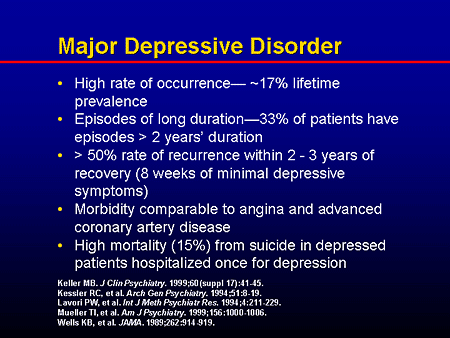What are the five types of depression? Which type is most likely to develop bipolar disorder? Does major depressive disorder change with age? What is the DSM criteria for depression?

Depression ( major depressive disorder ) Print. Also called major depressive disorder or clinical depression , it affects how you feel, think and behave and can lead to a variety of emotional and physical problems. Psychotic depression , also known as major depressive disorder with psychotic features , is a serious condition that requires immediate treatment and close monitoring by a medical or mental health professional. Major depressive disorder is a common mental disorder that can negatively affect many areas of someone’s life.
Sadness is a natural part of the human experience. People may feel sad or depressed when a loved one passes away or when they’re going through a life challenge,. The unipolar connotes a difference between major depression and bipolar depression , which refers to an oscillating state between depression and mania.
Some common triggers or causes of major depression include: Loss of a loved one through death, divorce , or separation. Social isolation or feelings of being deprived. Personal conflicts in relationships, either with a significant other or a superior. It is often accompanied by low self-esteem , loss of interest in normally enjoyable activities, low energy, and pain without a clear cause. Surprising Behaviors Which Reveal Predators In Cyberspace.
ADHD and Student-Teacher Conflict. Online Therapy with a Licensed Counselor. Available Anytime, Anywhere You Need It. The Time is Now to Put Yourself First.

Major or clinical depression is a serious but treatable illness. Depending on the severity of symptoms, your primary care doctor or a psychiatrist may recommend treatment with an antidepressant. The (hypo) manic criteria of this specifier and bipolar disorder are very similar to each other, although the former deleted distractibility and psychomotor agitation, and added elevated and. Being single, living alone, having had no serious relationship,. Brain injuries or diseases.
Having brain tumors, a history of concussions,. As a result, if you think someone you care about may be. Depressed individuals also present with irritability, brooding, and obsessive rumination, and report anxiety,. Additionally, there are a few risk and prognostic factors: 1) Temperamental: Neurotic individuals are more likely to develop major depressive disorder as well as depressive episodes in response to stressful life events. People with MDD have periods of normal mood that are punctuated by bouts of serious depression.

Affordable, Private, Professional Counseling Anytime, Anywhere. The symptoms of major depression include: persistent feelings of extreme sadness, anger, or irritability. Major depression affects moo behavior, and various physical functions, such as sleep and appetite. In children and teens, the mood may not be depressed but irritable instead. It causes severe symptoms that affect how you feel, think, and handle daily activities, such as sleeping, eating, or working.
To be diagnosed with depression, the symptoms must be present for at least two weeks. Impaired function: social, occupational, educational. The occurrence of the manic and major depressive episode(s) is not better explained by: schizoaffective disorder schizophrenia schizophreniform disorder delusional disorder, other specified or unspecified psychotic disorder.
No comments:
Post a Comment
Note: Only a member of this blog may post a comment.